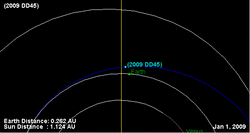Astronomy:2009 DD45
 2009 DD45: orbital animation of its 2009-flyby | |
| Discovery[1] | |
|---|---|
| Discovered by | SSS |
| Discovery site | Siding Spring Obs. |
| Discovery date | 27 February 2009 |
| Designations | |
| 2009 DD45 | |
| Minor planet category | NEO · Apollo[1][2] |
| Orbital characteristics[2] | |
| Epoch 31 May 2020 (JD 2459000.5) | |
| Uncertainty parameter 4[2] · 2[1] | |
| Observation arc | 7 days |
| |{{{apsis}}}|helion}} | 1.4952 AU |
| |{{{apsis}}}|helion}} | 0.9868 AU |
| 1.2410 AU | |
| Eccentricity | 0.2048 |
| Orbital period | 1.38 yr (505 d) |
| Mean anomaly | 39.793° |
| Mean motion | 0° 42m 46.8s / day |
| Inclination | 13.743° |
| Longitude of ascending node | 161.92° |
| 13.919° | |
| Earth MOID | 0.000339 astronomical unit|AU (0.132 LD) |
| Physical characteristics | |
| Mean diameter | 19±4 m (est. at 0.36)[2] |
| Rotation period | 1.2 h (poor)[2][3] |
| Geometric albedo | 0.36 (est.)[2] |
| SMASS = S[2] | |
| Absolute magnitude (H) | 25.8[1][2] |
2009 DD45 is a very small Apollo asteroid that passed near Earth at an altitude of 63,500 km (39,500 mi) on 2 March 2009 at 13:44 UTC. It was discovered by Australian astronomers with the Siding Spring Survey at the Siding Spring Observatory on 27 February 2009, only three days before its closest approach to the Earth.[4][5] Its estimated diameter is between 15 and 23 metres.[2] This is about the same size as a hypothetical object that could have caused the Tunguska event in 1908.[6]
BBC News Online cites the minimum distance as 72,000 km (45,000 mi) (about 1/5 lunar distances).[6][7] 2009 DD45 passed farther away (40 thousand miles versus 4 thousand miles) but was substantially larger than 2004 FU162, a small asteroid about 6 m (20 ft) across which came within about 6,500 km (4,000 mi) in 2004,[6] and is more similar in size to 2004 FH. With an observation arc of 7 days and an uncertainty parameter of 3, the asteroid will make its next close encounter with Earth on 29 February 2056 and then potentially around 3 March 2067.[2]
See also
- List of asteroid close approaches to Earth in 2009
References
- ↑ 1.0 1.1 1.2 1.3 "2009 DD45". Minor Planet Center. https://www.minorplanetcenter.net/db_search/show_object?object_id=2009+DD45. Retrieved 9 September 2020.
- ↑ 2.0 2.1 2.2 2.3 2.4 2.5 2.6 2.7 2.8 2.9 "JPL Small-Body Database Browser: (2009 DD45)". Jet Propulsion Laboratory. https://ssd.jpl.nasa.gov/sbdb.cgi?sstr=3448992. Retrieved 9 September 2020.
- ↑ "LCDB Data for (2009+DD45)". Asteroid Lightcurve Database (LCDB). http://www.minorplanet.info/PHP/generateOneAsteroidInfo.php?AstInfo=2009+DD45. Retrieved 9 September 2020.
- ↑ Kelly Beatty (2009-03-01). "Space Rock 2009 DD45 Buzzes Earth". Sky & Telescope. http://www.skyandtelescope.com/community/skyblog/observingblog/40504617.html. Retrieved 2009-03-04.
- ↑ Victoria Jaggard (2009-03-02). "Surprise Asteroid Just Buzzed Earth". National Geographic Society. Archived from the original on 4 March 2009. https://web.archive.org/web/20090304084808/http://news.nationalgeographic.com/news/2009/03/090302-asteroid-earth.html. Retrieved 2009-03-04.
- ↑ 6.0 6.1 6.2 "Space rock makes close approach". BBC News Online. 2009-03-03. Archived from the original on 4 March 2009. https://web.archive.org/web/20090304094851/http://news.bbc.co.uk/1/hi/sci/tech/7921279.stm. Retrieved 2009-03-03.
- ↑ Scientific American, May 2009 issue, listed the minimum distance as 72,200 km (p. 26)
External links
- Universe Today article on 2009 DD45
- 100-meter asteroid will pass Earth Monday! , Phil Plait's Bad Astronomy blog
- List Of Apollo Minor Planets (by designation), Minor Planet Center
- 2009 DD45 at NeoDyS-2, Near Earth Objects—Dynamic Site
- Ephemeris · Obs prediction · Orbital info · MOID · Proper elements · Obs info · Close · Physical info · NEOCC
- 2009 DD45 at ESA–space situational awareness
- 2009 DD45 at the JPL Small-Body Database
 |

